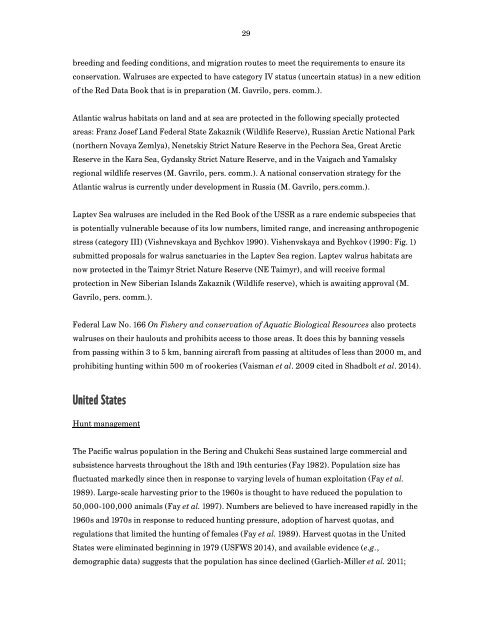The State of Circumpolar Walrus Populations
walrusreport
walrusreport
You also want an ePaper? Increase the reach of your titles
YUMPU automatically turns print PDFs into web optimized ePapers that Google loves.
29<br />
breeding and feeding conditions, and migration routes to meet the requirements to ensure its<br />
conservation. <strong>Walrus</strong>es are expected to have category IV status (uncertain status) in a new edition<br />
<strong>of</strong> the Red Data Book that is in preparation (M. Gavrilo, pers. comm.).<br />
Atlantic walrus habitats on land and at sea are protected in the following specially protected<br />
areas: Franz Josef Land Federal <strong>State</strong> Zakaznik (Wildlife Reserve), Russian Arctic National Park<br />
(northern Novaya Zemlya), Nenetskiy Strict Nature Reserve in the Pechora Sea, Great Arctic<br />
Reserve in the Kara Sea, Gydansky Strict Nature Reserve, and in the Vaigach and Yamalsky<br />
regional wildlife reserves (M. Gavrilo, pers. comm.). A national conservation strategy for the<br />
Atlantic walrus is currently under development in Russia (M. Gavrilo, pers.comm.).<br />
Laptev Sea walruses are included in the Red Book <strong>of</strong> the USSR as a rare endemic subspecies that<br />
is potentially vulnerable because <strong>of</strong> its low numbers, limited range, and increasing anthropogenic<br />
stress (category III) (Vishnevskaya and Bychkov 1990). Vishenvskaya and Bychkov (1990: Fig. 1)<br />
submitted proposals for walrus sanctuaries in the Laptev Sea region. Laptev walrus habitats are<br />
now protected in the Taimyr Strict Nature Reserve (NE Taimyr), and will receive formal<br />
protection in New Siberian Islands Zakaznik (Wildlife reserve), which is awaiting approval (M.<br />
Gavrilo, pers. comm.).<br />
Federal Law No. 166 On Fishery and conservation <strong>of</strong> Aquatic Biological Resources also protects<br />
walruses on their haulouts and prohibits access to those areas. It does this by banning vessels<br />
from passing within 3 to 5 km, banning aircraft from passing at altitudes <strong>of</strong> less than 2000 m, and<br />
prohibiting hunting within 500 m <strong>of</strong> rookeries (Vaisman et al. 2009 cited in Shadbolt et al. 2014).<br />
United <strong>State</strong>s<br />
Hunt management<br />
<strong>The</strong> Pacific walrus population in the Bering and Chukchi Seas sustained large commercial and<br />
subsistence harvests throughout the 18th and 19th centuries (Fay 1982). Population size has<br />
fluctuated markedly since then in response to varying levels <strong>of</strong> human exploitation (Fay et al.<br />
1989). Large-scale harvesting prior to the 1960s is thought to have reduced the population to<br />
50,000-100,000 animals (Fay et al. 1997). Numbers are believed to have increased rapidly in the<br />
1960s and 1970s in response to reduced hunting pressure, adoption <strong>of</strong> harvest quotas, and<br />
regulations that limited the hunting <strong>of</strong> females (Fay et al. 1989). Harvest quotas in the United<br />
<strong>State</strong>s were eliminated beginning in 1979 (USFWS 2014), and available evidence (e.g.,<br />
demographic data) suggests that the population has since declined (Garlich-Miller et al. 2011;


